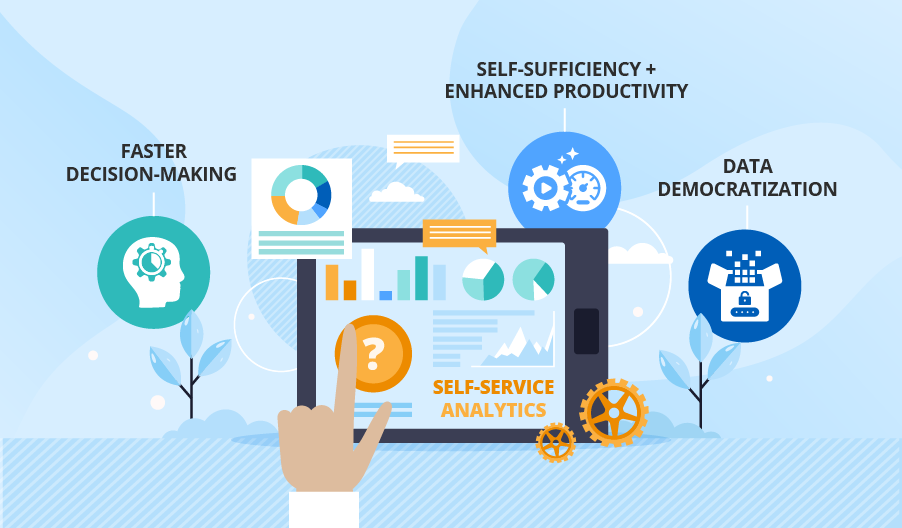Self-Service Analytics: When Data ‘Speaks’ to Business Users
Editor’s note: Marina explains why self-service analytics has gained much traction and shares how to leverage its capabilities to the fullest. If you consider integrating self-service analytics into your analytics environment or improving the existing solution, don’t hesitate to turn to ScienceSoft’s data analytics consulting services for professional assistance.
Nowadays, with data being widely recognized as a valuable asset, I see how companies are willing to make data analysis easily available for more business users. And the market offers them a solution for that – self-service data analytics. The term speaks for itself: when employed, self-service analytics allows business users to perform queries and generate reports on their own.
I bet this ambitious possibility raises some questions. Does that mean that traditional data analytics, when you have to request reports from the IT team to obtain insights, is a relic of times past? Can every employee access any corporate data now? How can people with no understanding of data modeling conduct effective analysis anyway? Keep on reading for the answers and see how to make self-service analytics work for you, not against you.

Top 3 reasons why I think self-service analytics is worth investing in
Data analytics is a well-known facilitator of data-driven decision-making for the business. However, there are times when traditional data analytics cannot satisfy urgent business requirements promptly. And here comes self-service analytics. Below you can see the self-service analytics benefits that make it a perfect amendment for the traditional data analysis:
1. Faster decision-making
With self-service analytics, business users don’t need to wait for the reports to be done for them: they can run queries and get whatever data they need to make timely decisions as fast as self-service analytics software allows. For example, in one of ScienceSoft’s projects, self-service analytics software enabled the customer to modify the existing reports according to the current business needs and conduct analysis just by pressing certain buttons on their user application home screen.
2. Self-sufficiency for business users + enhanced productivity for data analysts
Our clients particularly praise self-service analytics for the ability to make ad-hoc reporting and analytics accessible for employees with no technical background.
Additionally, as more employees obtain independence in running queries and conducting data analysis, data scientists and skilled analysts can shift their focus from simple analytics tasks towards their core and more complicated ones.
3. Data democratization
Self-service analytics facilitates data literacy and the spread of data-driven culture by granting access to data to a larger number of employees. Surely, it doesn’t mean that any employee gains free access to critical business data as access should be regulated by data governance policies. However, you should remember that the chosen security procedures may affect the performance of the analytics solution (e.g., it can take too long for the system to produce the required reports). To avoid such a negative outcome, I advise paying particular attention to tuning user access control. You may see this approach realized in one of our projects, where we set up an access model so that it wouldn’t slow down the overall self-service analytics solution. As a result, the customer could democratize data across their corporation with no risks of data breaches and solution performance issues.
3 steps for self-service analytics success
To ensure that self-service analytics brings the desired results, I advise you to focus on:
1. Informed choice of self-service analytics tools
When choosing self-service software, you should think about such aspects as data integration capabilities, advanced analytics capabilities, speed of reporting, visualization capabilities, data security, and much more. Taking into account that there are so many factors to consider, configuring the right technology stack for your self-service solution is much easier with professional help. With experienced consultants, you will be able to opt for software that satisfies both your immediate and long-term business goals.
Many customers I work with consider Microsoft Power BI to be a great facilitator of self-service data analysis. You are welcome to read my article about Power BI pros and cons, which may help you assess the feasibility of this self-service analytics tool for your company.
2. User adoption
Remember that by granting business users access to self-service business intelligence, you don’t automatically give these users the skillset they need for leveraging its potential. To help employees embrace new capabilities, I advise you to:
- Choose software with a simple and intuitive user interface, so that non-technical users could master it. In case you wonder what an intuitive user interface may look like, feel free to watch our Power BI demo.
- Follow the agile adoption approach: don’t rush your employees into harnessing the full breadth of your new software. Let them feel and appreciate the first tangible outcomes and gradually encourage them to explore software further.
- Conduct proper training for end-users to ensure that self-service analytics software is in full compliance with the skills they possess.
3. Data management procedures
Keep in mind that delivered reports are only as accurate as the data depicted in them, so you’ll have to set up proper data management procedures. Regardless of the fact that you employ self-service analytics software, the role of a data analyst is still crucial. Only a professional data analyst can perform such activities as data cleaning, preparing data sets that are further used by end-users, conducting advanced data analysis and monitoring system performance to ensure its high effectiveness.
So, how to let your business users own the data?
Although self-service analytics empowers more business users to make better decisions at the speed of business, reaching this level of data maturity and scaling your corporate analytical culture can be tough. You need to equip business users with the properly chosen self-service tools, the right level of access to data based on their business roles, and the guidance they need. More than often, achieving it is impossible without professional help. If you don’t know how to start your transition to a truly data-driven company, or you’ve encountered some problems within the existing self-service analytics solution, I am here to offer my assistance.

